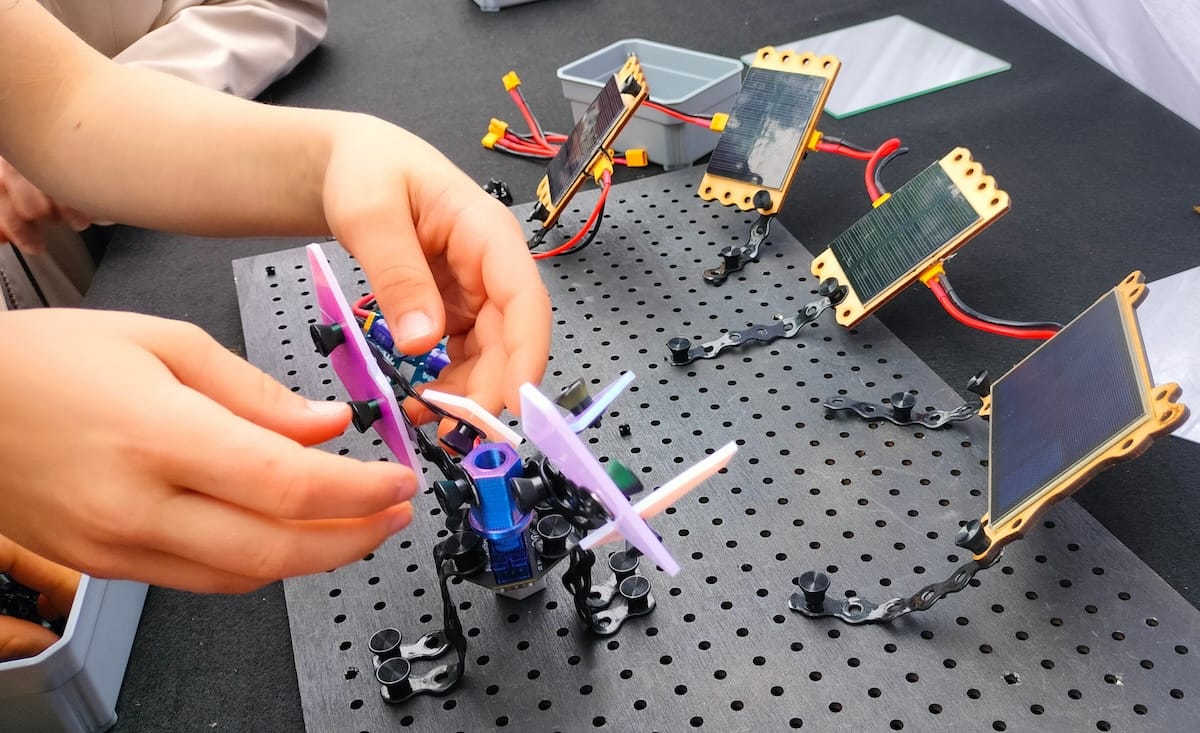Tilting at Solar Panels: The Importance of Timescales in Playful Learning

Designing Tinkering activities is about starting a conversation between a learner and some phenomena or idea.
When a child spins a top for the first time, she begins a dialog - "What if I do this?" - to which the top quickly responds "Then I do this." After a few tries the top stands up as it spins, defying both gravity and the child's expectations. She replies next with a slightly different spin, and it answers with slightly different behavior. The dialog goes back and forth until the child develops an intuitive sense of what the top will do.
This kind of conversation is something I'm always trying to create when designing playful learning activities. In Playing with the Sun, which emerged out of my PhD research with the Experimenting Experiencing Reflecting Project and Aarhus Public Libraries, the phenomena under investigation is energy - both generation and expression. Today children are used to gadgets that spend energy from batteries or wall sockets by moving, or lighting up, or making noise. But the generation side of the equation is much less familiar. I want to help children create an intuitive sense of how energy is created to act as a foundation for their understanding as it develops in the future.
An important part of inviting a child into a Tinkering dialog with any phenomena is designing or selecting materials that can respond in the same timescale as the child. This is why it’s difficult for a child to have a good exploratory dialogue with a solar panel. The kind she sees on rooftops don’t appear to do much of anything. Even if she could play with them directly, they probably wouldn't respond in any way that she could understand.
If she’s lucky enough to have something she can play with – perhaps a solar powered garden lamp or a flashlight that charges with a solar panel - she might try covering it with a blanket, or placing it under a desk lamp, just to see what happens. But the results of any of those experiments, what we might call the object's response to her opening questions, will take hours to show up. Children are busy; they have a lot to learn in a short time. Most won’t waste time talking with objects that don't respond in a timely fashion.
One of the design goals of Playing with the Sun is to get all the elements, like solar panels and hand crank generators, into the same timescale as the child. That’s why there are no batteries, and nothing that takes longer than a minute to charge or discharge. This is very much intentional: When something has energy, the child should be able to see the expression of that energy almost immediately. Put another way, the elements of the Playing with the Sun construction kit must be good conversationalists. In any good conversation, each side must respond to the other in a timely fashion.
Experimenting with the angle of the solar panel as a means of controlling speed.
The video above shows a loop of a child in dialog with a Playing with the Sun solar panel connected to a motor at Bloom festival in Copenhagen earlier this year, where a colleague from Dokk1 Library and I ran a drop-in workshop called “SunFlowers” for about 400 parents and children. The child sees that as he changes the angle of the solar panel in relation to the sun, the speed of the motor changes. If it were merely charging a battery that runs the motor, the feedback from tilting the panel would take much longer to have a noticeable effect. But because the motor changes speed soon after he tilts the panel, he’s able to start to make sense of this relationship. Putting all the elements into a timescale that the child is comfortable with makes this sense-making possible.
Accidental shading leads to inquiry and experimentation.
In this video from a different festival several months later, we see a younger child noticing, perhaps accidentally, that the shadow cast onto the solar panel by their head makes the motor slow down. They try moving their head intentionally, to see if it slows down again, and it does. Next they try using their hand and discovers that they can get subtle control of the speed by partially shading the solar panel. These are discoveries that wouldn’t be possible if the solar panel were simply charging a battery.
A good facilitator can invite this kind of playful exploration by demonstrating it, as we see in the video below. Here shading the solar panel becomes a form of social play, which is one of the best ways to invite a child into an exploration.
Why not just tell children that the angle of incidence of the sun affects the output of the solar panel? Future posts will engage that question more deeply. But the short answer is that learning through one's own explorations is more meaningful and engaging than learning by simply being told something. When it's possible to engage learners this way, we find it to be very valuable.
